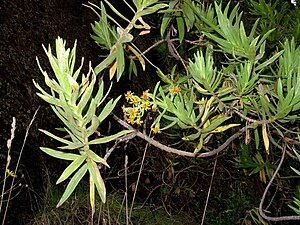
The silversword alliance, also known as the tarweeds, [1] refers to an adaptive radiation of around 30 species in the composite or sunflower family, Asteraceae. The group is endemic to Hawaii, and is derived from a single immigrant to the islands. For radiating from a common ancestor at an estimated 5.2±0.8 Ma, the clade is extremely diverse, composed of trees, shrubs, subshrubs, mat-plants, cushion plants, rosette plants, and lianas. [2]
The silversword alliance is named for its most famous and visually striking members, the silverswords. The species of the clade break down into three genera: Wilkesia, Argyroxiphium, and Dubautia. [3] There are three species of silverswords and two greenswords in the genus Argyroxiphium, confined to the islands of Maui and Hawaiʻi, and two species of Wilkesia (iliau) on Kauaʻi. The bulk of the species are placed in the genus Dubautia, which is widespread on all the main islands.
The genus Dubautia contains a wide variety of forms, including cushion plants, shrubs, trees, and lianas. [4]

Similar species frequently occur in the same habitat and are often difficult to tell apart. Hybrids frequently occur between Dubautia species, and between Dubautia and Argyroxiphium. As a result, there is some disagreement over the number of species, with modern sources giving between 28 and 33 species. [5] [6] [7] [8] [9] [10]
Characteristics
All members of the silversword alliance are perennials, but otherwise occupy a wide range of ecological niches. [11]
Evolution
All Hawaiian tarweeds trace their lineage back to a species of Pacific coast tarweed, very similar to extant species like Carlquistia muirii. [12] The last common ancestor of the silversword alliance was likely a mat and rhizome forming plant not more than .3 metres (0.98 ft) tall, with a chromosome number of 2n = 16, and perhaps another similar species. Species of Dubautia however have 2n = 14 chromosomes. How the silverswords' chromosome number arose is a matter of some uncertainty, but two major scientific theories have been proposed. One is that two ancestor species, one with n = 6 and one with n = 8 chromosomes hybridized, resulting in a n = 7 hybrid. The hybrid then, by allopolyploidy doubled its chromosome number spontaneously, leading to the resultant and extant 2n = 14 species. Alternatively, the modern chromosome number could have arisen from an ancestor like Anisocarpus scabridus, with a chromosome complement of n = 7, and then arisen by autopolyploidy, instead of needing to first hybridize. [13]
References
- ^ "Hawaiian silversword alliance, UH Botany". www.botany.hawaii.edu. Retrieved 2019-03-02.
- ^ Carlquist, S., B. G. Baldwin, and G. D. Carr, eds. 2003. Tarweeds & Silverswords: Evolution of the Madiinae (Asteraceae). Missouri Botanical Garden Press.
- ^ "Hawaiian silversword alliance, UH Botany". www.botany.hawaii.edu. Retrieved 2019-03-08.
- ^ Vickie Caraway, Gerald D. Carr and Clifford W. Morden (2001), "Assessment of hybridization and introgression in lava-colonizing Hawaiian Dubautia (Asteraceae: Madiinae) using RAPD markers", American Journal of Botany, 88 (9): 1688–1694, doi: 10.2307/3558414, JSTOR 3558414, PMID 21669703
- ^ Blonder, Benjamin; Baldwin, Bruce G.; Enquist, Brian J.; Robichaux, Robert H. (2016). "Variation and macroevolution in leaf functional traits in the Hawaiian silversword alliance (Asteraceae)" (PDF). Journal of Ecology. 104 (1): 219–228. doi: 10.1111/1365-2745.12497. ISSN 1365-2745.
- ^ Lawton‐Rauh, A.; Robichaux, R. H.; Purugganan, M. D. (2007). "Diversity and divergence patterns in regulatory genes suggest differential gene flow in recently derived species of the Hawaiian silversword alliance adaptive radiation (Asteraceae)". Molecular Ecology. 16 (19): 3995–4013. doi: 10.1111/j.1365-294X.2007.03445.x. ISSN 1365-294X. PMID 17784920. S2CID 18623958.
- ^ Friar, Elizabeth A.; McGlaughlin, Mitchell E. (2011-03-01). "Evolutionary diversification and geographical isolation in Dubautia laxa (Asteraceae), a widespread member of the Hawaiian silversword alliance". Annals of Botany. 107 (3): 357–370. doi: 10.1093/aob/mcq252. ISSN 0305-7364. PMC 3043929. PMID 21193480.
- ^ Friar, Elizabeth A.; Prince, Linda M.; Cruse-Sanders, Jennifer M.; McGlaughlin, Mitchell E.; Butterworth, Charles A.; Baldwin, Bruce G. (2008). "Hybrid Origin and Genomic Mosaicism of Dubautia scabra (Hawaiian Silversword Alliance; Asteraceae, Madiinae)". Systematic Botany. 33 (3): 589–597. doi: 10.1600/036364408785679815. ISSN 0363-6445. JSTOR 40211922. S2CID 86257628.
- ^ Sanderson, Michael J.; Baldwin, Bruce G. (1998-08-04). "Age and rate of diversification of the Hawaiian silversword alliance (Compositae)". Proceedings of the National Academy of Sciences. 95 (16): 9402–9406. Bibcode: 1998PNAS...95.9402B. doi: 10.1073/pnas.95.16.9402. ISSN 0027-8424. PMC 21350. PMID 9689092.
- ^ For instance, Blonder and Baldwin 2016 cite 33 species, Friar 2011 cites 33, Lawton‐Rauh 2007 cites 30, Sanderson and Baldwin cite 28.
- ^ "Hawaiian silversword alliance, UH Botany". www.botany.hawaii.edu. Retrieved 2019-03-08.
- ^ "Hawaiian silversword alliance, UH Botany". www.botany.hawaii.edu. Retrieved 2019-03-08.
- ^ "Hawaiian silversword alliance, UH Botany". www.botany.hawaii.edu. Retrieved 2019-03-08.